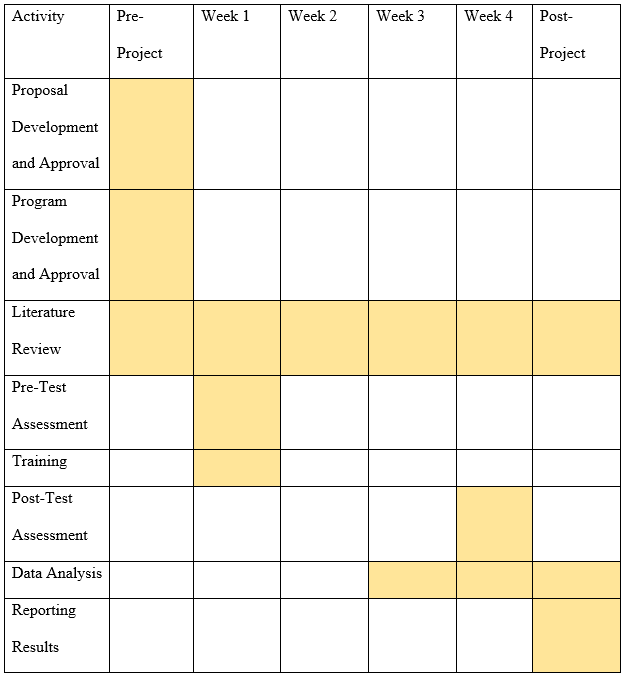Introduction
The primary purpose of this study is to evaluate the effectiveness of EHR system as seen by patients and healthcare professionals. The project will involve all the hospital’s employees who use EHR. It has been acknowledged that adherence to information system providers’ recommendations improves the quality of healthcare services (Sittig et al., 2018). Sampling is one of the most important aspects of any research, and it is essential to ensure that all stakeholders’ views are analyzed (Lau, 2017).
Since the number of employees using EHR is comparatively small, all of them will be involved in the project. The overall number of healthcare professionals that will participate in the research will be 400 people. The same number of patients will take part in the study, so once this number is reached, patient sampling will stop. Patients will complete a survey on their discharge day while employees will complete questionnaires at the beginning and at the end of the project.
Timeline
The project aimed at evaluating the benefits of the use of an effective EHR system will be implemented within nine weeks (approximately two months). This phase will be divided into three major stages: preparation, implementation, and evaluation (see Table 1). During preparation, the provider of the software will send a set of recommendations regarding possible improvements with the focus on patient safety. During week one, the healthcare practitioners who will take part in the study will receive written consent forms with all the relevant data regarding the project details. They will also receive the questionnaires regarding the use of EHR.
This will be the time when the first discussions will take place. The provider will send the recommendations that will be disseminated among the participants (employees), and some training will be given. Nurse leaders will be central to this process, as they will train the staff and manage the meetings. The preparation stage will last for two weeks and will involve intensive training and discussions.

The implementation part of the project will start in week 3. Patients will receive care based on the new recommendations and will be invited to participate in the study. Each week 100 patients will be given written consent forms and will complete questionnaires concerning the quality of services they get, as well as such aspects as trust, security, and satisfaction. The implementation stage will last four weeks and will end with the collection of employees’ views regarding the amended EHR. During this component of the project, nurses will meet weekly to share their views on opportunities and challenges regarding the use of EHR.
The final stage of the program implementation will be data analysis and the completion of the report. Data analysis will be conducted with the help of statistical software SPSS. The use of such instruments ensures the validity of the findings and convenience as a large bulk of data can be analyzed within a short period of time (Moule, Aveyard, & Goodman, 2016). The findings will be presented in the form of a report that will highlight the prevalent attitudes towards new care.
Tables and graphs will help readers to perceive information more easily. The report will be available from the hospital’s information system, and all employees will be able to access it. During week 9, discussions of the results of the project will be held. Healthcare professionals will share their views on the project, recommendations, improvements (if any), challenges, and further steps.
Resources and Budget
The research will not require substantial funding, which makes it an affordable and effective project (see Table 2). The compensation of healthcare practitioners’ time will require the largest investment. However, it is still relatively small since other forms of compensation and motivation will be utilized. For instance, more flexibility regarding shifts will be offered to the participants. The staff will also be motivated to implement the project as it will potentially improve their working conditions leading to decreased workload. It is also important to allocate some funds to purchase the data analysis tool and the services the provider of the EHR system will offer. Overall, the project will not be associated with considerable investment, although it can be important to stress the relevance of the study when discussing the implementation of the program with the hospital’s administration.
Table 2. Project Budget.
Conclusion
On balance, it is necessary to note that the implementation phase of the project will take up to nine weeks and will require the allocation of $1000. The research will involve approximately 400 employees and the same quantity of patients. Data collection, analysis, and dissemination will be facilitated by the use of the information system employed at the healthcare facility. The discussion of the findings will ensure the acceptance of the changes.
References
Lau, F. (2017). Methods for survey studies. In F. Lau & C. Kuziemsky (Eds.), Handbook of eHealth evaluation: An evidence-based approach (pp. 227-243). Victoria, Canada: University of Victoria.
Moule, P., Aveyard, H., & Goodman, M. (2016). Nursing research: An introduction. Thousand Oaks, CA: SAGE.
Sittig, D. F., Salimi, M., Aiyagari, R., Banas, C., Clay, B., Gibson, K. A.,… & Sirajuddin, A. M. (2018). Adherence to recommended electronic health record safety practices across eight health care organizations. Journal of the American Medical Informatics Association, 25(7), 913-918.